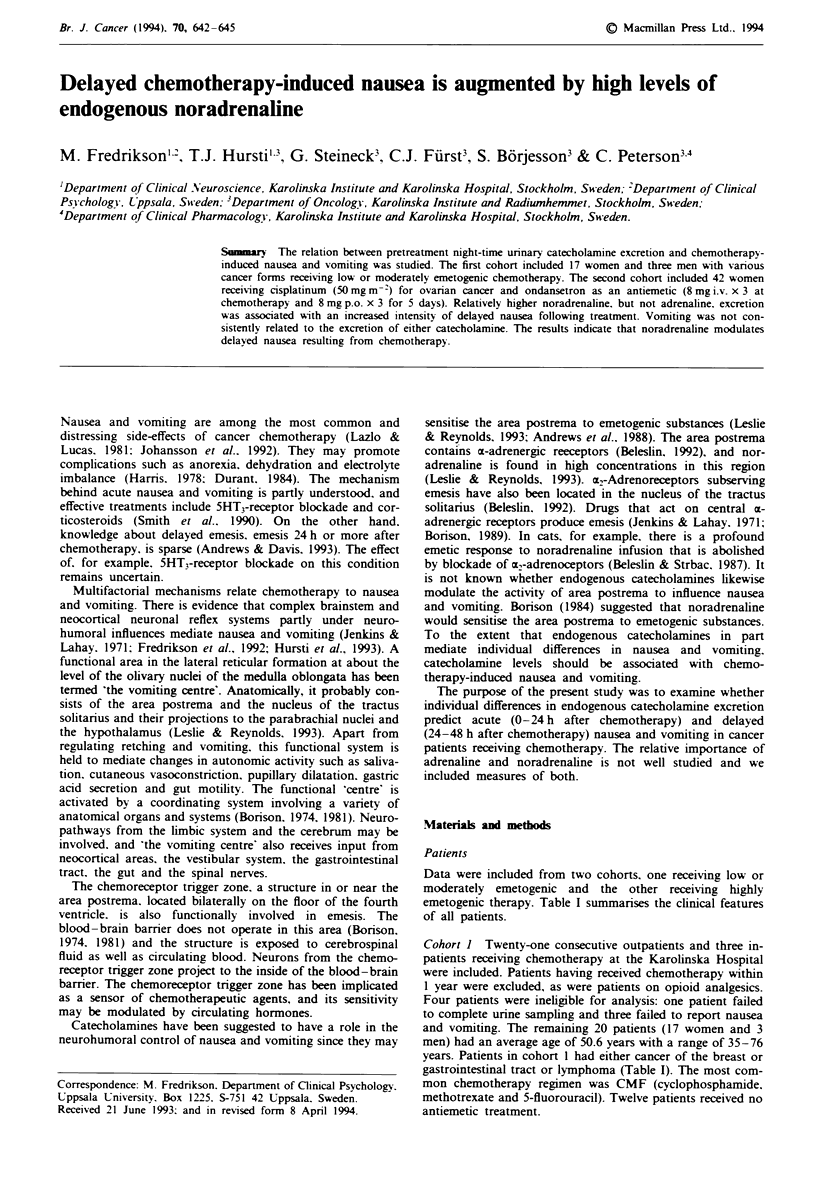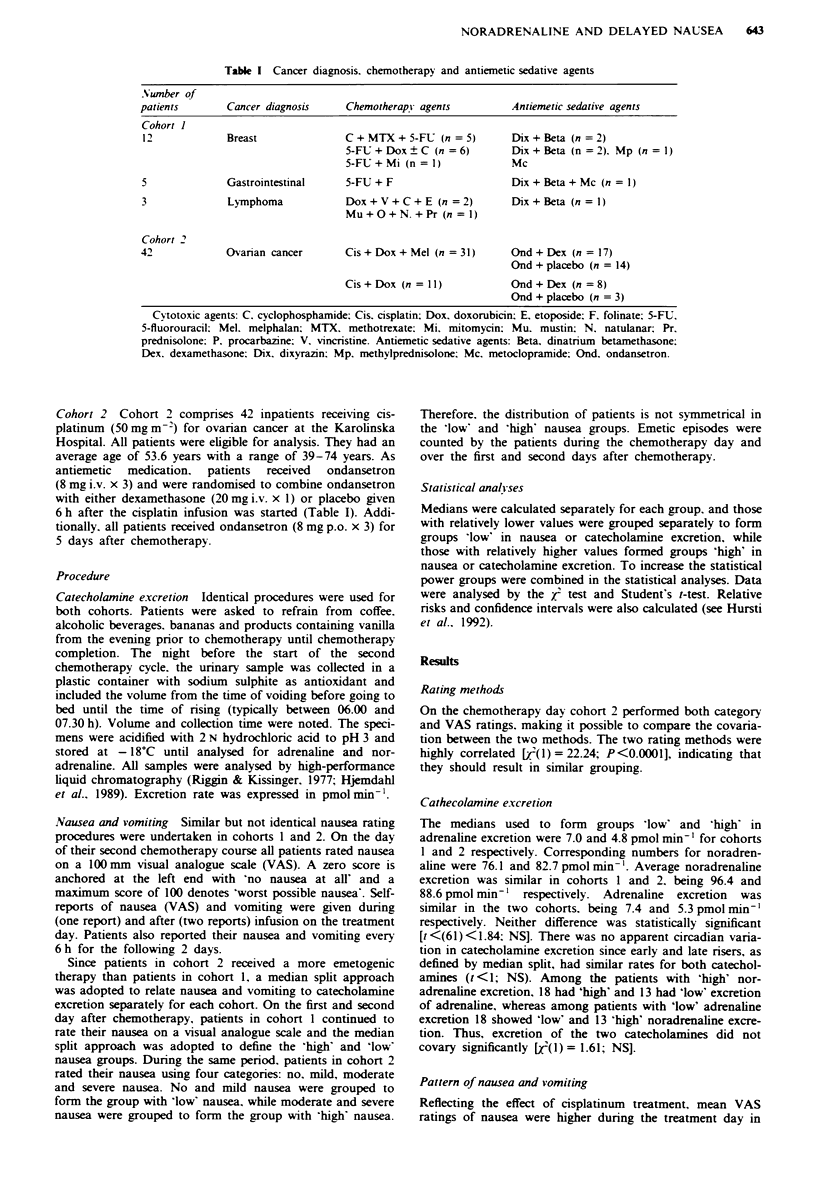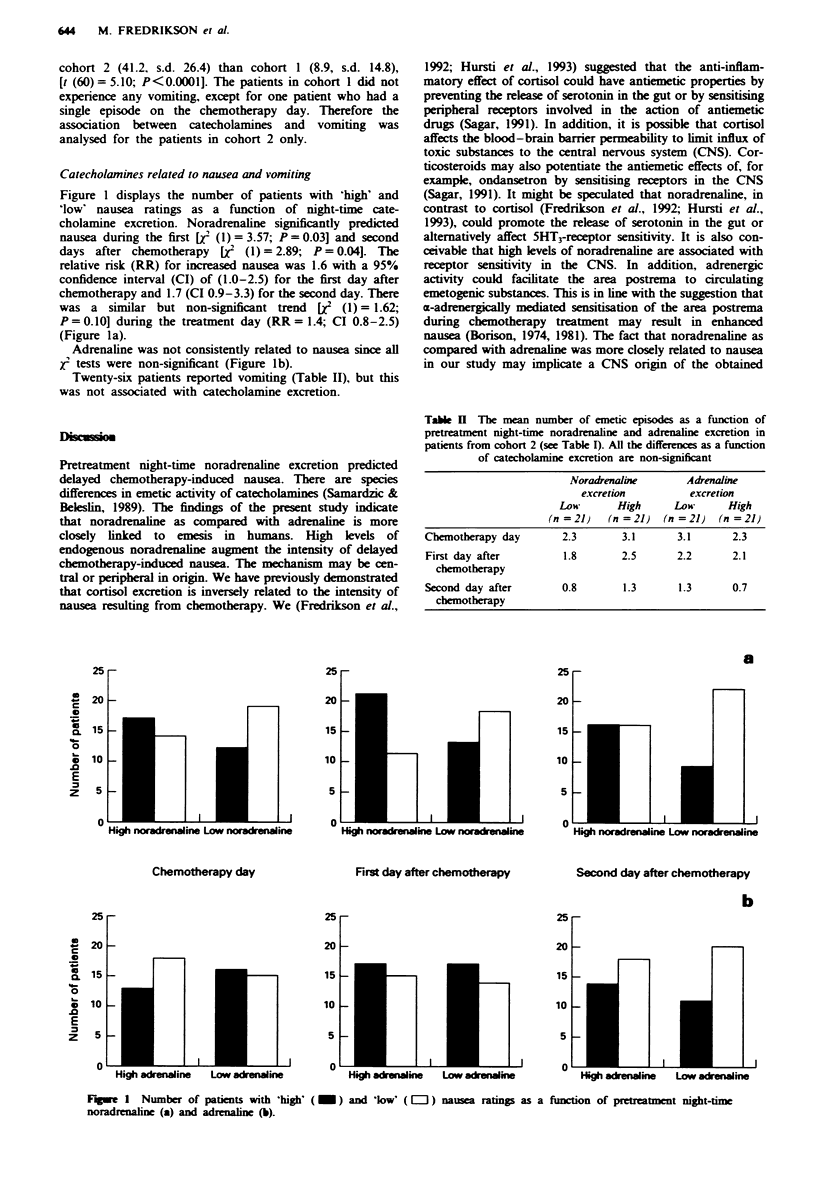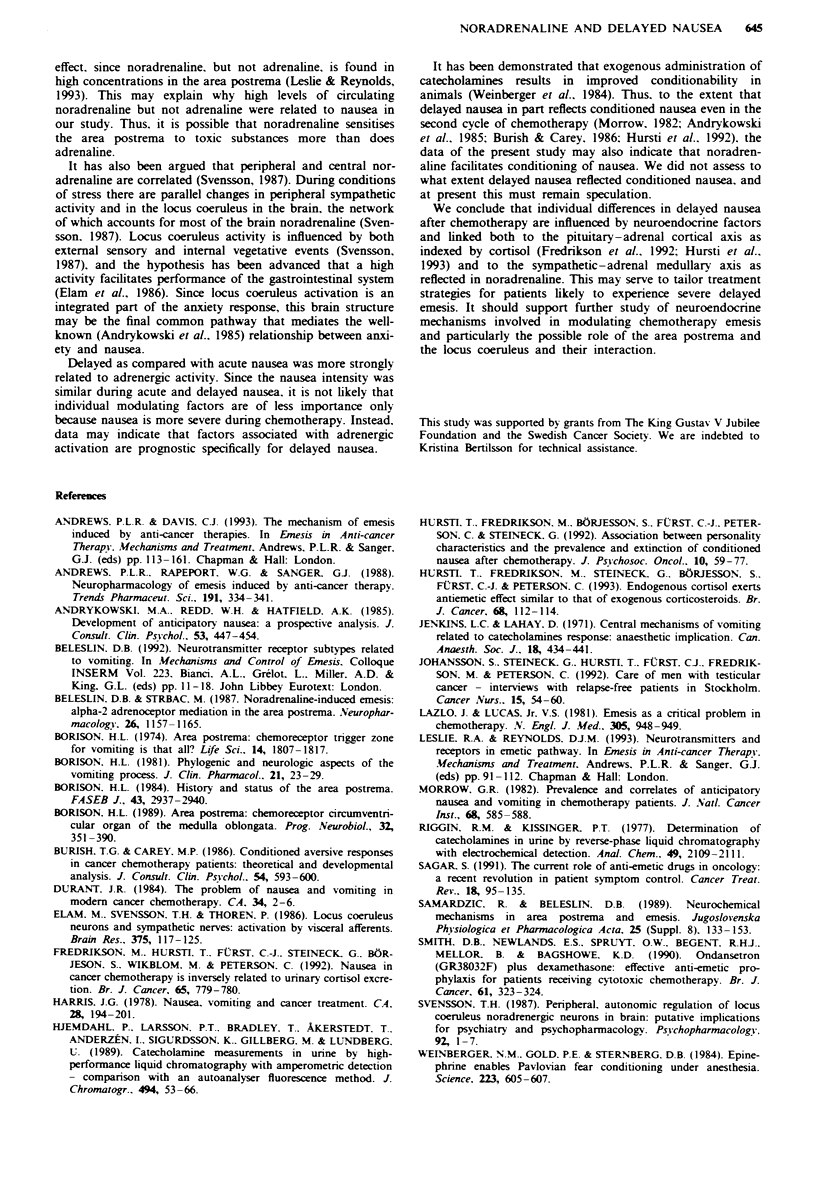Abstract
The relation between pretreatment night-time urinary catecholamine excretion and chemotherapy-induced nausea and vomiting was studied. The first cohort included 17 women and three men with various cancer forms receiving low or moderately emetogenic chemotherapy. The second cohort included 42 women receiving cisplatinum (50 mg m-2) for ovarian cancer and ondansetron as an antiemetic (8 mg i.v. x 3 at chemotherapy and 8 mg p.o. x 3 for 5 days). Relatively higher noradrenaline, but not adrenaline, excretion was associated with an increased intensity of delayed nausea following treatment. Vomiting was not consistently related to the excretion of either catecholamine. The results indicate that noradrenaline modulates delayed nausea resulting from chemotherapy.
Full text
PDF



Selected References
These references are in PubMed. This may not be the complete list of references from this article.
- Andrews P. L., Rapeport W. G., Sanger G. J. Neuropharmacology of emesis induced by anti-cancer therapy. Trends Pharmacol Sci. 1988 Sep;9(9):334–341. doi: 10.1016/0165-6147(88)90106-x. [DOI] [PubMed] [Google Scholar]
- Andrykowski M. A., Redd W. H., Hatfield A. K. Development of anticipatory nausea: a prospective analysis. J Consult Clin Psychol. 1985 Aug;53(4):447–454. doi: 10.1037//0022-006x.53.4.447. [DOI] [PubMed] [Google Scholar]
- Beleslin D. B., Strbac M. Noradrenaline-induced emesis. Alpha-2 adrenoceptor mediation in the area postrema. Neuropharmacology. 1987 Aug;26(8):1157–1165. doi: 10.1016/0028-3908(87)90262-0. [DOI] [PubMed] [Google Scholar]
- Borison H. L. Area postrema: chemoreceptor circumventricular organ of the medulla oblongata. Prog Neurobiol. 1989;32(5):351–390. doi: 10.1016/0301-0082(89)90028-2. [DOI] [PubMed] [Google Scholar]
- Borison H. L. Area postrema: chemoreceptor trigger zone for vomiting--is that all? Life Sci. 1974 May 16;14(10):1807–1817. doi: 10.1016/0024-3205(74)90399-3. [DOI] [PubMed] [Google Scholar]
- Borison H. L. History and status of the area postrema. Fed Proc. 1984 Dec;43(15):2937–2940. [PubMed] [Google Scholar]
- Burish T. G., Carey M. P. Conditioned aversive responses in cancer chemotherapy patients: theoretical and developmental analysis. J Consult Clin Psychol. 1986 Oct;54(5):593–600. doi: 10.1037//0022-006x.54.5.593. [DOI] [PubMed] [Google Scholar]
- Elam M., Thorén P., Svensson T. H. Locus coeruleus neurons and sympathetic nerves: activation by visceral afferents. Brain Res. 1986 Jun 4;375(1):117–125. doi: 10.1016/0006-8993(86)90964-9. [DOI] [PubMed] [Google Scholar]
- Fredrikson M., Hursti T., Fürst C. J., Steineck G., Börjeson S., Wikblom M., Peterson C. Nausea in cancer chemotherapy is inversely related to urinary cortisol excretion. Br J Cancer. 1992 May;65(5):779–780. doi: 10.1038/bjc.1992.165. [DOI] [PMC free article] [PubMed] [Google Scholar]
- Harris J. G. Nausea, vomiting and cancer treatment. CA Cancer J Clin. 1978 Jul-Aug;28(4):194–201. doi: 10.3322/canjclin.28.4.194. [DOI] [PubMed] [Google Scholar]
- Hjemdahl P., Larsson P. T., Bradley T., Akerstedt T., Anderzén I., Sigurdsson K., Gillberg M., Lundberg U. Catecholamine measurements in urine by high-performance liquid chromatography with amperometric detection--comparison with an autoanalyser fluorescence method. J Chromatogr. 1989 Sep 29;494:53–66. doi: 10.1016/s0378-4347(00)82656-0. [DOI] [PubMed] [Google Scholar]
- Hursti T. J., Fredrikson M., Steineck G., Börjeson S., Fürst C. J., Peterson C. Endogenous cortisol exerts antiemetic effect similar to that of exogenous corticosteroids. Br J Cancer. 1993 Jul;68(1):112–114. doi: 10.1038/bjc.1993.295. [DOI] [PMC free article] [PubMed] [Google Scholar]
- Jenkins L. C., Lahay D. Central mechanisms of vomiting related to catecholamine response: anaesthetic implication. Can Anaesth Soc J. 1971 Jul;18(4):434–441. doi: 10.1007/BF03025695. [DOI] [PubMed] [Google Scholar]
- Johansson S., Steineck G., Hursti T., Fredrikson M., Fürst C. J., Peterson C. Aspects of patient care. Interviews with relapse-free testicular cancer patients in Stockholm. Cancer Nurs. 1992 Feb;15(1):54–60. [PubMed] [Google Scholar]
- Laszlo J., Lucas V. S., Jr Emesis as a critical problem in chemotherapy. N Engl J Med. 1981 Oct 15;305(16):948–949. doi: 10.1056/NEJM198110153051609. [DOI] [PubMed] [Google Scholar]
- Morrow G. R. Prevalence and correlates of anticipatory nausea and vomiting in chemotherapy patients. J Natl Cancer Inst. 1982 Apr;68(4):585–588. [PubMed] [Google Scholar]
- Riggin R. M., Kissinger P. T. Determination of catecholamines in urine by reverse-phase liquid chromatography with electrochemical detection. Anal Chem. 1977 Nov;49(13):2109–2111. doi: 10.1021/ac50021a052. [DOI] [PubMed] [Google Scholar]
- Sagar S. M. The current role of anti-emetic drugs in oncology: a recent revolution in patient symptom control. Cancer Treat Rev. 1991 Jun;18(2):95–135. doi: 10.1016/0305-7372(91)90009-o. [DOI] [PubMed] [Google Scholar]
- Smith D. B., Newlands E. S., Spruyt O. W., Begent R. H., Rustin G. J., Mellor B., Bagshawe K. D. Ondansetron (GR38032F) plus dexamethasone: effective anti-emetic prophylaxis for patients receiving cytotoxic chemotherapy. Br J Cancer. 1990 Feb;61(2):323–324. doi: 10.1038/bjc.1990.62. [DOI] [PMC free article] [PubMed] [Google Scholar]
- Weinberger N. M., Gold P. E., Sternberg D. B. Epinephrine enables Pavlovian fear conditioning under anesthesia. Science. 1984 Feb 10;223(4636):605–607. doi: 10.1126/science.6695173. [DOI] [PubMed] [Google Scholar]


